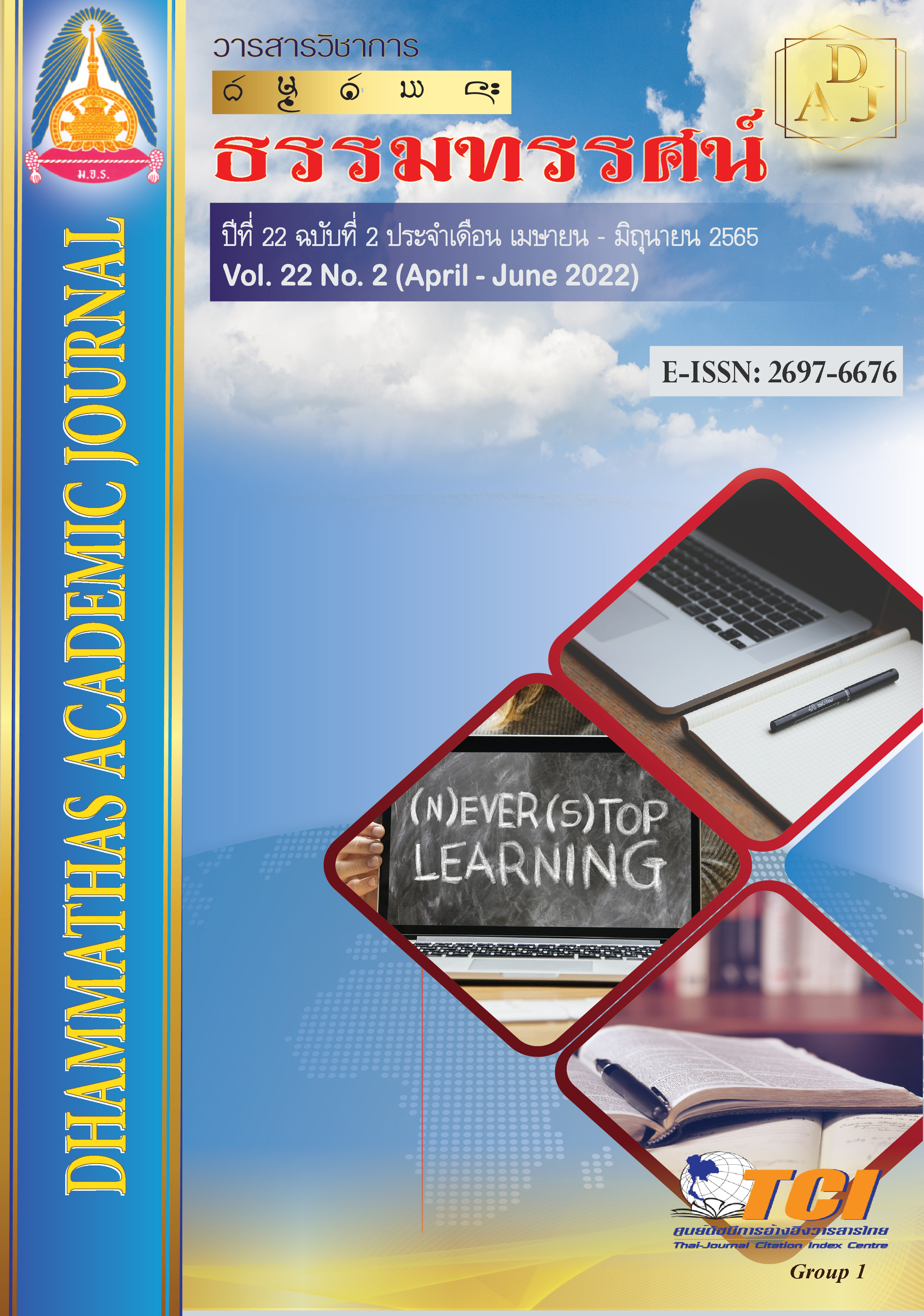Analyzing Elements of Designing Lesson Plans that Focuses on Students’ Ideas in Teaching Practice using Lesson Study and Open Approach to Learn Students’ Ideas
Main Article Content
Abstract
The purpose of this research was to analyze the design elements of lesson plans that emphasized students' ideas in teaching practice using Lesson Study and Open Approach to learn students’ ideas. This research is case study that target group is the Lesson Study team at grade 5, that consisted of 4 members, consisting of 2 pre-service teachers and 2 co-observing teachers, semester 2 of the academic year 2020, Chumchon Ban Kaeng Khro Nong Phai School, Kaeng Khro District, Chaiyaphum Province that this was obtained by considering teaching practice using continuous and consistent Lesson Study. The research instruments were files note of lesson plan design, camera, audio recorder and video camera. Data were analyzed using analytical description.
The results showed that: The Lesson Study team together designed a lesson plan that focused on students’ ideas in teaching practice that used Lesson Study and Open Approach to learn students’ ideas have four elements namely; 1) Anticipate students’ ideas by focusing on solving problems in textbooks on their own, distinguish the ideas of problem solving between the teacher's ideas and the student's ideas, and anticipate students' difficulties that will arise from the ideas students use to solve problems; 2) create instruction, design media according to students' ideas by using instruction in textbooks as a guideline for creating instructions; 3) find connections and 4) determine where to observe the student's ideas by determining both the position and the time to be observed in step 2 of the Open Approach.
Article Details

This work is licensed under a Creative Commons Attribution-NonCommercial-NoDerivatives 4.0 International License.
เพื่อให้เป็นไปตามกฎหมายลิขสิทธิ์ ผู้นิพนธ์ทุกท่านต้องลงลายมือชื่อในแบบฟอร์มใบมอบลิขสิทธิ์บทความ ให้แก่วารสารฯ พร้อมกับบทความต้นฉบับที่ได้แก้ไขครั้งสุดท้าย นอกจากนี้ ผู้นิพนธ์ทุกท่านต้องยืนยันว่าบทความ ต้นฉบับที่ส่งมาตีพิมพ์นั้น ได้ส่งมาตีพิมพ์เฉพาะในวารสาร วิชาการธรรม ทรรศน์ เพียงแห่งเดียวเท่านั้น หากมีการใช้ ภาพหรือตารางของผู้นิพนธ์อื่นที่ปรากฏในสิ่งตีพิมพ์อื่นมาแล้ว ผู้นิพนธ์ต้องขออนุญาตเจ้าของลิขสิทธิ์ก่อน พร้อมทั้ง แสดงหนังสือที่ได้รับการยินยอมต่อบรรณาธิการ ก่อนที่บทความจะได้รับการตีพิมพ์References
กตัญญุตา บางโท. (2558). ออกแบบโจทย์ปัญหาคณิตศาสตร์เพื่อสนับสนุนการคิดวิเคราะห์ของนักเรียน. (วิทยานิพนธ์ปรัชญาดุษฎีบัณฑิต). ขอนแก่น: มหาวิทยาลัยขอนแก่น.
กระทรวงศึกษาธิการ. (2551). หลักสูตรแกนกลางการศึกษาขั้นพื้นฐาน พุทธศักราช 2551. เข้าถึงได้จาก http://www.curriculum2551.com
นรรัชต์ ฝันเชียร. (2563). การออกแบบแผนการจัดการเรียนรู้ด้วยวิธี Backward Design. เข้าถึงได้จาก https://www.trueplookpanya.com/blog/content/79306/-blog-teamet-
ไมตรี อินทร์ประสิทธิ์. (2557). กระบวนการแก้ปัญหาในคณิตศาสตร์ระดับโรงเรียน. ขอนแก่น: เพ็ญพรินติ้ง.
_______. (2559). เอกสารประกอบการอบรมเชิงปฏิบัติการและกิจกรรมเปิดชั้นเรียนระดับชาติ ครั้งที่ 10. ขอนแก่น: แอนนาออฟเซต.
_______. (2561ก). การศึกษาชั้นเรียนด้วยวิธีการแบบเปิด: PLC ภาคปฏิบัติจริงในโรงเรียน. ขอนแก่น: สถาบันวิจัยและพัฒนาวิชาชีพครูสำหรับอาเซียน.
_______. (2561ข). นวัตกรรมการศึกษาชั้นเรียน (Lesson Study) และวิธีการแบบเปิด (Open Approach) เพื่อยกระดับคุณภาพชั้นเรียน. ขอนแก่น: สถาบันวิจัยและพัฒนาวิชาชีพครูสำหรับอาเซียน.
_______. (2561ค). การพัฒนาครูแนวใหม่ ด้วยนวัตกรรมการศึกษาชั้นเรียน (Lesson Study) ให้ตอบโจทย์ความต้องการครูในศตวรรษที่ 21 สำหรับการสอนคณิตศาสตร์ ระดับชั้นประถมศึกษา. ขอนแก่น: สถาบันวิจัยและพัฒนาวิชาชีพครูสำหรับอาเซียน.
เริงนภา อำทะวงษ์. (2563). การออกแบบแผนการจัดการเรียนรู้ของทีมการศึกษาชั้นเรียน. จังหวัดชัยภูมิ: โรงเรียนชุมชนบ้านแก้งคร้อหนองไผ่
สุกัญญา จตุรานนท์, รวีวรรณ เพียเพ็ง และวิริยา ศรีจันทร์บุญ. (2563). แผนการจัดการเรียนรู้: การหาพื้นที่. จังหวัดชัยภูมิ: โรงเรียนชุมชนบ้านแก้งคร้อหนองไผ่.
อัญชิสา วรรณวัติ. (2562). การเชื่อมโยงแนวคิดทางคณิตศาสตร์ของนักเรียนในชั้นเรียนที่ใช้การศึกษาชั้นเรียนและวิธีการแบบเปิด. การประชุมวิชาการเสนอผลงานวิจัยระดับบัณฑิตศึกษาแห่งชาติ ครั้งที่ 20, หน้า 1863-1872. ขอนแก่น: มหาวิทยาลัยขอนแก่น.
Akiba, M. et al. (2018). Lesson Study design features for supporting collaborative teacher learning. Teaching and Teacher Education, 77(1), 352-365.
Becker, J. & Shimada, S. (1997). The Open-Ended Approach: A New Proposal for Teaching Mathematics. Reston, Virginia: National Council of Teachers of Mathematics.
Fujii, T. (2016). Designing and adapting tasks in lesson planning: a critical process of Lesson Study. ZDM Mathematics Education, 48(4), 411-423.
Hitotatsumatatsu, S. (2011). Mathematics for Elementary Level Grade 5 V. 2 1st print. Khon Kaen: KKU Printing.
Huang, R. & Shimizu, Y. (2016). Improving teaching, developing teachers and teacher developers, and linking theory and practice through lesson study in mathematics: an international perspective. ZDM Mathematics Education, 48(4), 393-409.
Intaros, P. & Inprasitha, M. (2019). How Students’ Mathematical Ideas Emerged through Flow of Lesson in Classroom Using Lesson Study and Open Approach. Psychology, 10, 864-876.
Jones, K. (2002). Issues in the teaching and learning of geometry. In: Linda Haggarty (Ed), Aspects of Teaching Secondary Mathematics: perspectives on practice. London: Routledge Falmer.
Kumar, S. (2017). Teaching Materials and Teaching Aids – I. Retrieved from https://www.researchgate.net/publication/318215081_Teaching_materials__and_teaching_aids-1_teaching_material
Llinares, S., Fernández, C. & Sánchez-Matamoros, G. (2016). Changes in how teachers anticipate secondary students’ answers. Eurasia Journal of of Mathematics, Science & Technology Education, 12(8), 2155-2170.
MacDonald, A., et al. (2012). Early childhood mathematics education. In B. Perry, T. Lowrie, T. Logan, A. MacDonald, & J. Greenlees (Eds.). Research in mathematics education in Australasia 2008-2011, pp. 169-192. Rotterdam: Sense Publishers.
Margolis, A. (2020). Zone of Proximal Development, Scaffolding and Teaching Practice. Cultural-Historical Psychology, 16(3), 15-26.
NCTM. (2000). Executive Summary Principles and Standards for School Mathematics. Retrieved from https://www.nctm.org/uploadedFiles/Standards_and _Positions/PSSM_ExecutiveSummary.pdf
Niedderer, H. et al. (2007). Learning process studies. Retrieved from https://core.ac.uk/download/pdf/52298697.pdf
Nohda, N. (2000). Teaching by Open-Approach Method in Japanese Mathematics Classroom. Proceeding of the 24th Conference of the International Group for the Psychology of Mathematics Education (PME 24), pp. 39-54. Hiroshima, Japan: Hiroshima University.
Norwich, B. & Ylonen, A. (2015). A design-based trial of Lesson Study for assessment purposes: evaluating a new classroom based dynamic assessment approach. European Journal of Special Needs Education, 30(2), 253-273.
OECD. (2009). Creating Effective Teaching and Learning Environments: First Results from TALIS. Retrieved from https://www.oecd.org/education/school/43023606.pdf
Önen, E. (2015). Connections between Modes of Thinking and Learning Approaches: Implications for Education and Research. Journal of Education and Learning, 4(1), 84-96.
Schoenfeld, A. H. (1985). Mathematical problem solving. New York: Academic Press.
Stigler, J. W. and Hiebert, J. (1999). The teaching gap. New York: Free Press.
Tularam, G. A. (2016). Traditional vs Non-traditional Teaching and Learning Strategies-the case of E-learning!. Proceedings of International Conference on Engineering Education and Research, pp. 1-11. Australia: University of Western Sydney.
Tularam, G. A. & Machisella, P. (2018). Traditional vs Non-traditional Teaching and Learning Strategies-the case of E-learning!. International journal for mathematics teaching and learning, 19(1), 129-158.
Voigt, J. (1996). Negotiation of Mathematical Meaning in Classroom Processes: Social Interaction and Learning Mathematics. In Cobb, P., Goldin, G.A., & Greer, B., Theories of Mathematical Learning, pp. 21-50. NJ: Lawrence Erlbaum Associates.
Zhu, Y., Yu, W. & Cai, J. (2017). Understanding Students’ Mathematical Thinking for Effective Teaching: A Comparison between Expert and Nonexpert Chinese Elementary Mathematics Teachers. EURASIA Journal of Mathematics, Science and Technology Education, 14(1), 213-224.

